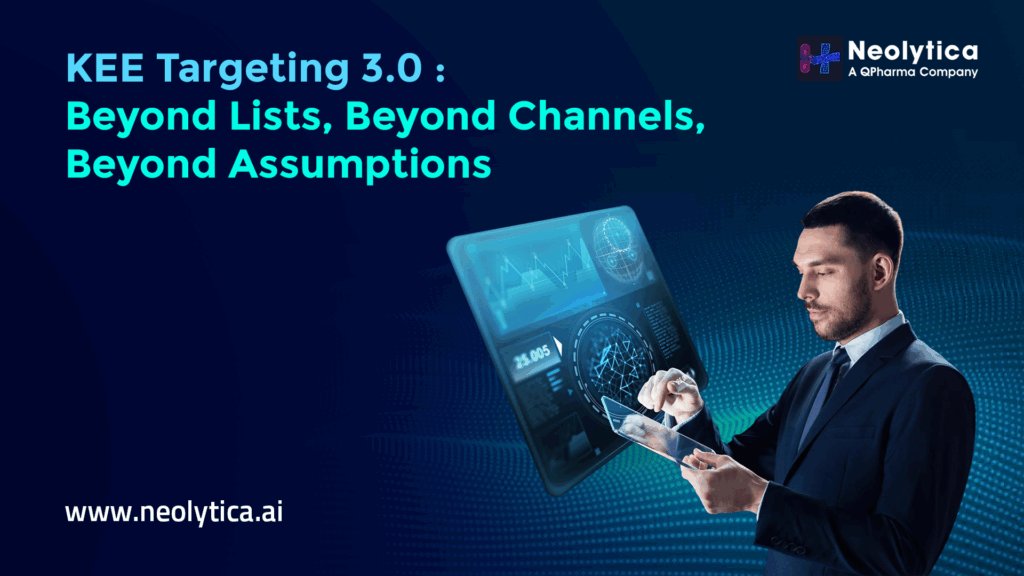KEE targeting has evolved. Version 1.0 was spreadsheets of “top names.” Version 2.0 chased digital activity, who posts, where, and how often. KEE Targeting 3.0 goes further: it connects role, behavior, and impact to reveal who actually moves clinical decisions and why. If your medical affairs, commercial, or market access teams still rely on static KOL lists or single-channel dashboards, it’s time to modernize your KEE targeting approach.
What KEE Targeting 3.0 means in plain terms
- From reach to impact: Don’t just count followers; measure whether an expert’s voice leads to observable changes in clinician behavior.
- From channels to contexts: Treat congresses, publications, advisory rooms, specialist forums, and select social platforms as one connected ecosystem.
- From snapshots to trajectories: Track sentiment by topic and how it shifts around abstracts, safety updates, or guideline cycles.
- From activity to enablement: Equip experts with the right evidence and materials at the right time so influence becomes action.
This is KEE targeting designed for real-world adoption, not vanity metrics.
The three pillars: role → behavior → impact
1) Role (what the expert does):
Guideline authors, trial PIs, service-line leads, and registry stewards carry different kinds of authority. Clear KOL/KEE mapping starts by labeling practical roles so outreach matches day-to-day responsibilities.
2) Behavior (how they engage):
Some experts publish methodical reviews; others drive case-based debates or host workshops. Behavior profiles keep KEE targeting aligned to the right format, small-room advisory for method reviewers, rapid Q&A for fast-cycle educators, DOL-style briefs for digitally active clinicians.
3) Impact (what changes after they speak):
Track signals that matter: peer debate that triggers follow-ups, article saves and requests for data, protocol tweaks, MSL inquiries, demo interest, trial referrals, and payer conversations. These outcome-linked signals separate influence from impressions.
Build a topic-first expert universe
Create a topic-focused, curated database that tags experts by:
- Therapy area and subtopic (including method focus, like real-world evidence or imaging)
- Care setting (academic center, IDN, community practice)
- Geography and access dynamics (trial capacity, IRB experience)
- Roles across medical education, guidelines, and committees
This keeps KEE targeting tied to current medical priorities, not generic “top KOL” lists.
Add sentiment and timing, because context matters
- Sentiment by topic: Capture supportive, neutral, or skeptical tone per indication or data set. Watch for inflection points after congress abstracts, label updates, or safety notices.
- Cadence & windows: Quieter KEEs often weigh in at key moments; plan outreach around those windows.
- Bridge voices: Experts who work across institutions or subspecialties help ideas travel faster, even if they post infrequently.
What to measure (and what to stop measuring)
Measure:
- Role-weighted impact: guideline sections, committee work, session chairs.
- Behavior-fit engagement that leads somewhere: who attends, who asks for data, who invites follow-ups.
- Impact metrics: debate → documented actions, downloads → MSL requests, demo interest, formulary discussions.
- Sentiment change by topic: Shifts from supportive/neutral/skeptical around abstracts, safety updates, or guideline cycles, paired with downstream actions (e.g., spike in MSL inquiries, data pack requests, trial referrals) to confirm that sentiment movement translated into real impact.
De-prioritize:
- Raw post counts, generic impressions, and non-HCP audiences when your goal is practice change.
How Neolytica operationalizes KEE Targeting 3.0
Neolytica’s Ti-Expert platform brings role, behavior, and impact into one workspace so your KEE targeting is current, compliant, and actionable:
- Unified expert profiles: Publications, congress activity, advisory work, specialist forums, and curated digital signals, continuously reconciled.
- Topic-level tagging: Filter experts by therapy area, subtopic, method focus, and geography so KOL mapping aligns with your medical plan.
- Impact & sentiment tracking: See tone by topic and the downstream actions it correlates with (MSL requests, data downloads, demo interest, protocol changes).
- Enablement workflows: Package the right evidence at the right moment, turning expert influence into measurable outcomes.
- Outcome dashboards: Replace vanity metrics with the signals leadership cares about: trial activation, protocol shifts, quality HCP engagements.
Bottom line
KEE Targeting 3.0 moves you beyond lists, beyond channels, beyond assumptions, to a model that maps real roles, reads behavior in context, and measures impact in outcomes. If you’re ready to replace noise with actionable signals, Neolytica can help you build and activate a topic-first expert universe that actually changes practice.

